
Georges Braque was a major 20th-century French painter, collagist, draughtsman, printmaker and sculptor. His most notable contributions were in his alliance with Fauvism from 1905, and the role he played in the development of Cubism. Braque's work between 1908 and 1912 is closely associated with that of his colleague Pablo Picasso. Their respective Cubist works were indistinguishable for many years, yet the quiet nature of Braque was partially eclipsed by the fame and notoriety of Picasso.

José Victoriano González-Pérez , better known as Juan Gris, was a Spanish painter born in Madrid who lived and worked in France for most of his active period. Closely connected to the innovative artistic genre Cubism, his works are among the movement's most distinctive.

Cubism is an early-20th-century avant-garde art movement begun in Paris that revolutionized painting and the visual arts, and influenced artistic innovations in music, ballet, literature, and architecture. Cubist subjects are analyzed, broken up, and reassembled in an abstract form—instead of depicting objects from a single perspective, the artist depicts the subject from multiple perspectives to represent the subject in a greater context. Cubism has been considered the most influential art movement of the 20th century. The term cubism is broadly associated with a variety of artworks produced in Paris or near Paris (Puteaux) during the 1910s and throughout the 1920s.

Guillaume Apollinaire was a French poet, playwright, short story writer, novelist and art critic of Polish descent.
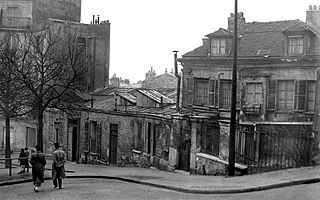
The Bateau-Lavoir is the nickname of a building in the Montmartre district of the 18th arrondissement of Paris that is famous in art history as the residence and meeting place for a group of outstanding early 20th-century artists such as Pablo Picasso, men of letters, theatre people, and art dealers. It is located at No. 13 Rue Ravignan at Place Emile Goudeau, just below the Place du Tertre.
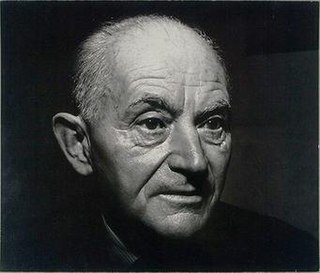
Daniel-Henry Kahnweiler was a German-born art collector, and one of the most notable French art dealers of the 20th century. He became prominent as an art gallery owner in Paris beginning in 1907 and was among the first champions of Pablo Picasso, Georges Braque and the Cubist movement in art.
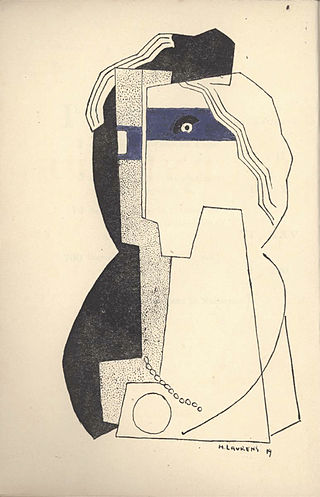
Henri Laurens was a French sculptor and illustrator.

Jean Dominique Antony Metzinger was a major 20th-century French painter, theorist, writer, critic and poet, who along with Albert Gleizes wrote the first theoretical work on Cubism. His earliest works, from 1900 to 1904, were influenced by the neo-Impressionism of Georges Seurat and Henri-Edmond Cross. Between 1904 and 1907, Metzinger worked in the Divisionist and Fauvist styles with a strong Cézannian component, leading to some of the first proto-Cubist works.

The Section d'Or, also known as Groupe de Puteaux or Puteaux Group, was a collective of painters, sculptors, poets and critics associated with Cubism and Orphism. Based in the Parisian suburbs, the group held regular meetings at the home of the Duchamp brothers in Puteaux and at the studio of Albert Gleizes in Courbevoie. Active from 1911 to around 1914, members of the collective came to prominence in the wake of their controversial showing at the Salon des Indépendants in the spring of 1911. This showing by Albert Gleizes, Jean Metzinger, Robert Delaunay, Henri le Fauconnier, Fernand Léger and Marie Laurencin, created a scandal that brought Cubism to the attention of the general public for the first time.

Pierre Reverdy was a French poet whose works were inspired by and subsequently proceeded to influence the provocative art movements of the day, Surrealism, Dadaism and Cubism. The loneliness and spiritual apprehension that ran through his poetry appealed to the Surrealist credo. He, though, remained independent of the prevailing "-isms", searching for something beyond their definitions. His writing matured into a mystical mission seeking, as he wrote: "the sublime simplicity of reality."

Le pigeon aux petit pois, sometimes referred to as Dove with green peas, is a 1911 oil on canvas painting by Pablo Picasso. It is an example of Picasso's Cubist works and has an estimated value of €23 million. The painting was one of five artworks stolen from the Musée d'Art Moderne de la Ville de Paris on 20 May 2010, which together are valued at €100 million. It has so far not been recovered and its whereabouts remain unknown.

Cubist sculpture developed in parallel with Cubist painting, beginning in Paris around 1909 with its proto-Cubist phase, and evolving through the early 1920s. Just as Cubist painting, Cubist sculpture is rooted in Paul Cézanne's reduction of painted objects into component planes and geometric solids; cubes, spheres, cylinders, and cones. Presenting fragments and facets of objects that could be visually interpreted in different ways had the effect of 'revealing the structure' of the object. Cubist sculpture essentially is the dynamic rendering of three-dimensional objects in the language of non-Euclidean geometry by shifting viewpoints of volume or mass in terms of spherical, flat and hyperbolic surfaces.
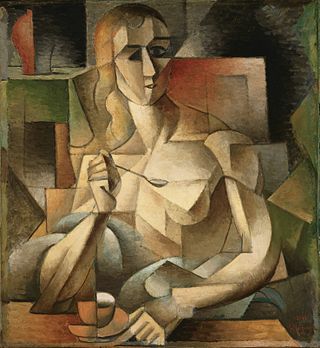
Tea Time is an oil painting created in 1911 by the French artist and theorist Jean Metzinger. It was exhibited in Paris at the Salon d'Automne of 1911, and the Salon de la Section d'Or, 1912.
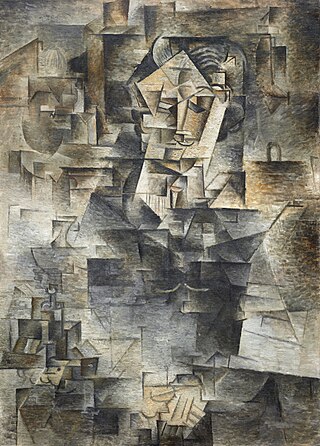
Portrait of Daniel-Henry Kahnweiler is an oil on canvas painting by Pablo Picasso in the Analytical Cubism style. It was completed in the autumn of 1910 and depicts the prominent art dealer Daniel-Henry Kahnweiler, who played an important role in supporting Cubism. The painting is housed in the collection of the Art Institute of Chicago.

Proto-Cubism is an intermediary transition phase in the history of art chronologically extending from 1906 to 1910. Evidence suggests that the production of proto-Cubist paintings resulted from a wide-ranging series of experiments, circumstances, influences and conditions, rather than from one isolated static event, trajectory, artist or discourse. With its roots stemming from at least the late 19th century, this period is characterized by a move towards the radical geometrization of form and a reduction or limitation of the color palette. It is essentially the first experimental and exploratory phase of an art movement that would become altogether more extreme, known from the spring of 1911 as Cubism.

Léonce Rosenberg was an art collector, writer, publisher, and one of the most influential French art dealers of the 20th century. His greatest impact was as a supporter and promoter of the cubists, especially during World War I and in the years immediately after.

Les Peintres Cubistes, Méditations Esthétiques, is a book written by Guillaume Apollinaire between 1905 and 1912, published in 1913. This was the third major text on Cubism; following Du "Cubisme" by Albert Gleizes and Jean Metzinger (1912); and André Salmon, Histoire anecdotique du cubisme (1912).

Lady with a her Dressing Table is a painting by the French artist Jean Metzinger. This distilled synthetic form of Cubism exemplifies Metzinger's continued interest, in 1916, towards less surface activity, with a strong emphasis on larger, flatter, overlapping abstract planes. The manifest primacy of the underlying geometric configuration, rooted in the abstract, controls nearly every element of the composition. The role of color remains primordial, but is now restrained within sharp delineated boundaries in comparison with several earlier works. The work of Juan Gris from the summer of 1916 to late 1918 bears much in common with that of Metzinger's late 1915 – early 1916 paintings.

Crystal Cubism is a distilled form of Cubism consistent with a shift, between 1915 and 1916, towards a strong emphasis on flat surface activity and large overlapping geometric planes. The primacy of the underlying geometric structure, rooted in the abstract, controls practically all of the elements of the artwork.

The Fruit Bowl is an early 20th century drawing by Juan Gris. The work was produced as part of a collaboration between Gris and Pierre Reverdy to commission a book filled with lithographs made from the former's paintings. The project was interrupted by the onset of World War I in 1914 and never finished. Reverdy composed a poem titled The Fruit Bowl to accompany the painting. Gris' work is currently in the collection of the Metropolitan Museum of Art.




















